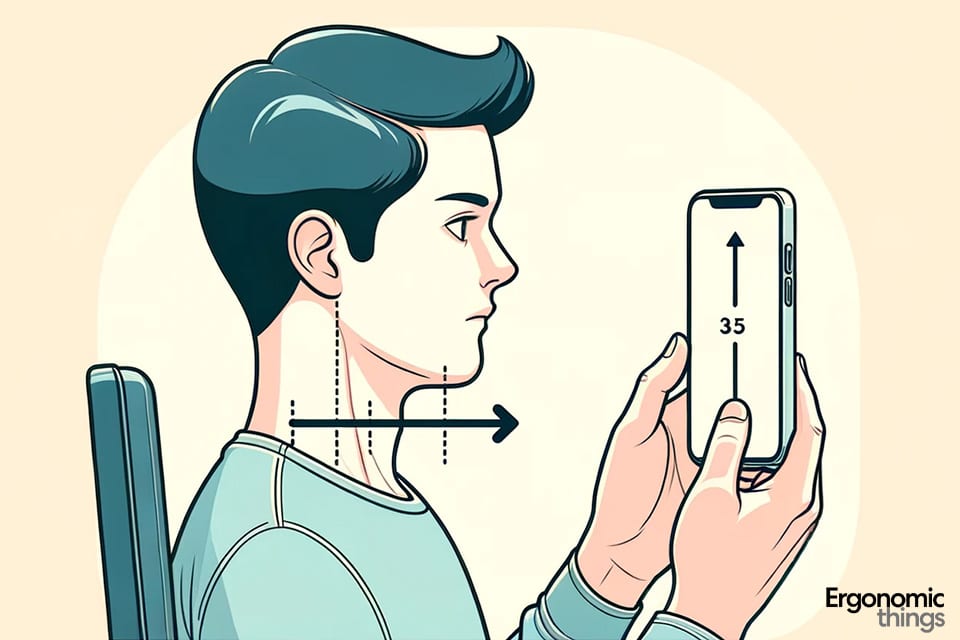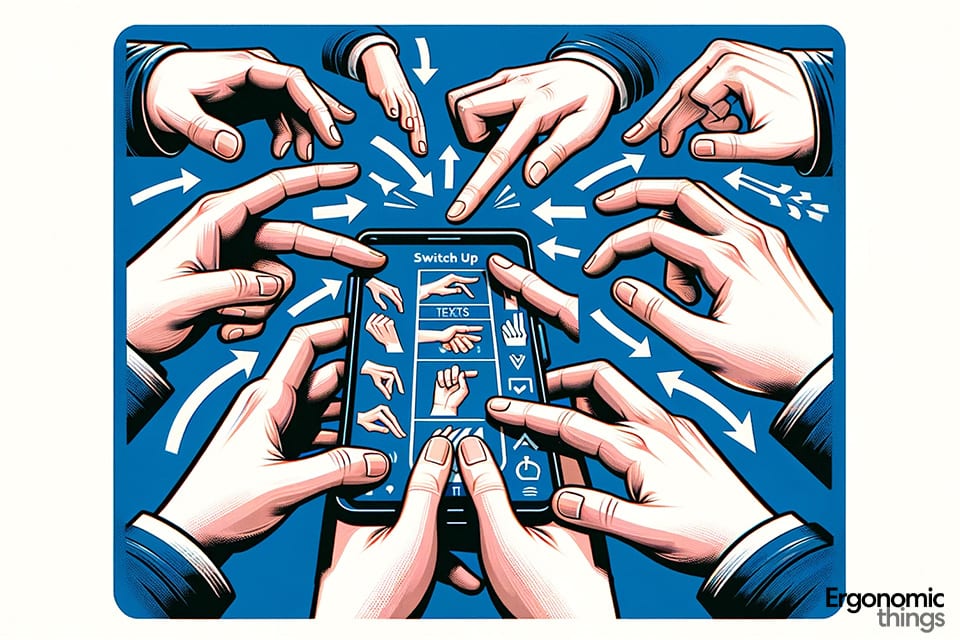In the digital age, smartphones are indispensable, yet their prolonged use often leads to physical discomfort. Recognizing the importance of ergonomic practices can significantly mitigate neck and hand strain. This extended guide includes additional strategies to enhance your digital well-being.
Ergonomics focuses on optimizing our interaction with devices to prevent strain. As smartphones become more integral to our daily lives, understanding and applying ergonomic principles is crucial for maintaining physical health.
Why Smartphone Ergonomics for Healthier Use?
Using your smartphone shouldn’t be a pain in the neck—literally. With most of us glued to our screens for hours each day, it’s crucial to adopt phone ergonomics to avoid common discomforts like neck and shoulder strain and texting thumb.
These practical smartphone ergonomic tips will help you use your phone comfortably and keep those aches at bay.
1. Elevate Your Phone to Eye Level to Ease Neck Strain
Keep your spine happy by holding your phone up higher. This simple change can prevent you from bending your neck too much, which often leads to neck pain from smartphone use. A good rule of thumb is to keep your device at eye level as much as possible, especially when reading or browsing for extended periods.

2. Switch Up Your Fingers When Texting and Scrolling

Relying on just one finger to do all the work can lead to texting thumb, a painful condition from overuse. Mix it up by using different fingers to tap, scroll, and type. This technique not only gives some fingers a break but also distributes the workload, helping prevent thumb strain from smartphone use.
3. Opt for a Pop Socket for a More Comfortable Grip
A pop socket isn’t just a trendy phone accessory; it’s a boon for ergonomic phone use. Attaching one to your phone allows for a more relaxed grip, reducing the risk of hand and wrist strain. Plus, it makes holding your phone for longer periods much more comfortable, whether you’re texting, browsing, or taking selfies.
4. Use Voice Commands to Give Your Thumbs a Rest
Embrace the convenience of voice-to-text technology to minimize typing and swiping. Switching to voice commands can significantly reduce the strain on your fingers, especially if you’re prone to texting thumb. It’s a smart way to use your phone hands-free, cutting down on typing-related hand strain.
5. Prefer Headphones or Speakerphone to Avoid Cradling Your Phone
Holding your phone between your shoulder and ear is a no-go for neck health. For long conversations, use headphones or switch to speakerphone. This practice helps maintain a comfortable posture, preventing neck and shoulder pain from phone use.
6. Don’t Forget to Take Regular Breaks
Your neck and eyes will thank you for taking frequent breaks. Aim for a short pause every 15 to 30 minutes to stretch and rest your eyes. Regular breaks help combat neck strain and keep you feeling fresh, making them a must for anyone looking to improve their smartphone ergonomics.
Embrace Ergonomics for Comfortable Smartphone Use
Adopting these ergonomic tips can make a world of difference in how you use your smartphone. From using a pop socket for a better grip to taking regular breaks to refresh, every small change contributes to a more comfortable and healthier phone experience. Say goodbye to neck and shoulder strain and texting thumb, and hello to smarter, strain-free smartphone use.
FAQs on Smartphone Ergonomics
Q1: What is smartphone ergonomics?
Smartphone ergonomics refers to the study and application of designing smartphone use in a way that fits the user’s body naturally, minimizing discomfort and risk of injury. It involves adopting certain practices and using accessories to improve posture, reduce strain on the neck, shoulders, hands, and eyes, and enhance overall comfort while using a smartphone.
Q2: How can I avoid neck and shoulder strain while using my smartphone?
To avoid neck and shoulder strain, hold your phone at eye level to keep your spine in a neutral position, and avoid bending your neck forward for extended periods. Using headphones or the speakerphone function during long calls can also prevent you from cradling the phone between your shoulder and ear, reducing strain.
Q3: What is texting thumb, and how can I prevent it?
Texting thumb is a condition characterized by pain and inflammation in the thumb and wrist, resulting from repetitive motion injuries caused by excessive texting and scrolling. To prevent it, alternate your fingers when using your phone, take regular breaks, and consider using voice-to-text features to give your thumbs a rest.
Q4: How does a pop socket help with smartphone ergonomics?
A pop socket attaches to the back of your phone, providing a more secure and comfortable grip. It reduces the risk of hand and wrist injuries by allowing for a relaxed hold, preventing the phone from slipping, and making it easier to maneuver the phone with less strain on your fingers.
Q5: Why should I use voice commands for smartphone use?
Using voice commands reduces the need for physical typing, swiping, and tapping, which can lead to hand strain and texting thumb. Voice-to-text technology allows you to perform tasks hands-free, giving your fingers a break and making smartphone use more comfortable and ergonomic.
Q6: What is the importance of using headphones or speakerphone during calls?
Using headphones or the speakerphone function during calls eliminates the need to hold your phone or cradle it between your shoulder and ear, which can lead to neck and shoulder strain. It promotes a more natural posture, reducing the risk of discomfort and pain.
Q7: How often should I take breaks from using my smartphone?
It’s recommended to take a break every 15 to 30 minutes of continuous smartphone use. Short breaks allow your muscles to relax, reducing the risk of strain and fatigue. During these breaks, stretch your neck, shoulders, and hands, and rest your eyes to prevent strain.
Q8: Are there any specific exercises to counteract the effects of prolonged smartphone use?
Yes, there are specific exercises designed to alleviate discomfort from prolonged smartphone use, including neck stretches, shoulder rolls, wrist flexor and extensor stretches, and thumb stretches. Incorporating these exercises into your routine can help maintain flexibility and reduce tension.

